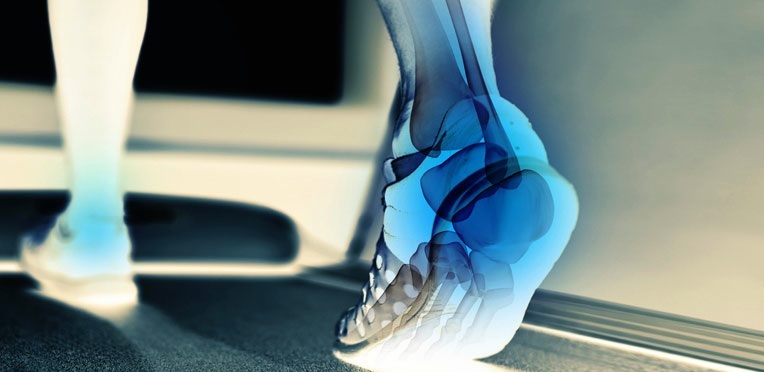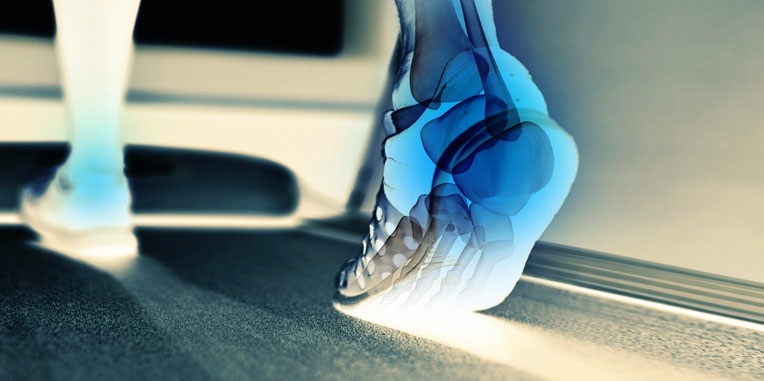Heel Pain – What’s the “Sole-lution!”
Posted on 29th January 2018 at 16:02
Plantarfasciopathy (often referred to as plantarfasciitis) is the most common clinical diagnosis for heel pain. This usually starts as a result of inflammation of the soft tissues that sit underneath the foot and insert into the heel bone (see picture below) but as time progresses it can lead to adaptation and change within the tissues similar to what is seen in tendonopathy (see previous running blog).

It is reported by people who lead active lifestyle’s (in particular runners) and also in those that lead a more sedentary lifestyle. Changes in footwear, being overweight and training overload have been reported as some possible reasons for its onset.
However, before a clinical diagnosis can be made it is important to rule out other potential sources of heel pain. These include referred pain from a disc or nerve in the lower back, referred pain from a “trigger point” (i.e a knot) in one of the calf muscles (commonly the Soleus muscle – see picture below), a stress response in the heel bone, Calcaneal Bursitis or the presence of a bone spur in the heel.
So treatment wise what are your options and how easy is this problem to fix? Firstly, the good news is that there are numerous treatment interventions available to physiotherapists that have been shown to help with plantarfasciopathy. These include taping to help unload the painful soft tissues, manual therapy including massage techniques to help release areas of tension, acupuncture to help reduce pain and exercise based rehabilitation to help improve the function and support of the muscles in the foot and often other major muscle groups in the leg. Try to avoid doing lots of stretching…this can often make things worse! The not so good news I’m afraid is that there is no clear cook-book recipe for managing this problem and it can often take a minimum of 8-12 weeks to see a tangible improvement in your symptoms, especially if the symptoms have been there for some time. Added to this a combination of treatment interventions is normally required. Act quickly to try to reduce the time that the problem is there for.
In the early, very acute phase patients often report their pain as severe at times at it can also be very irritable. What is meant by this is that the pain is easily aggravated and does not settle quickly once present. One possible explanation for this is that we have to still walk every day and this doesn’t give ample enough rest time for the soft tissues to settle. Like all acute soft tissue injuries similar principles apply (relative rest, ice, possibly anti-inflammatories and unloading the painful area). A gel heel cup can sometimes be of help in the very early stages of pain. Patients will often report pain and stiffness in the heel first thing in the morning, pain on every step of walking or with prolonged walking/standing and pain on walking after prolonged sitting.
There also appears to be a case building for the use of Shockwave Therapy in Plantarfasciopathy. Shockwave therapy is the delivery of abrupt, high amplitude pulses of mechanical energy, similar to sound waves, generated by a machine and transmitted to the body via a treatment unit. Shock waves stimulate angiogenesis (new blood vessels) and neurogenesis (new nerve cells). This has been shown to have some effectiveness in treating plantarfasciopathy (Wang et al 2006, Yin et al 2014). However, further research is required in this area. To date the exact physiological mechanisms at this stage are poorly understood, but it appears that the cells undergo microtrauma which promotes the inflammatory processes that are associated with stimulating wound healing mechanisms. Unlike many conservative treatments for plantarfasciopathy, Extracorporeal Shock Wave Therapy can produce negative side effects. The procedure can be painful and can cause pain immediately following the procedure. Other side effects from it are minor skin bruising, reddening, and swelling around the treated area.
The take home message today…heel pain should not be put up with. Act fast and stop this problem becoming a more chronic issue that will take longer to settle. Get early advice from a physiotherapist and things should settle reasonably swiftly.
Tagged as: Acupuncture, Exercise therapy, Heel pain, Kinesiotape, Manual therapy, Physiotherapy, Plantarfasciitis, Plantarfasciopathy, Running
Share this post:




